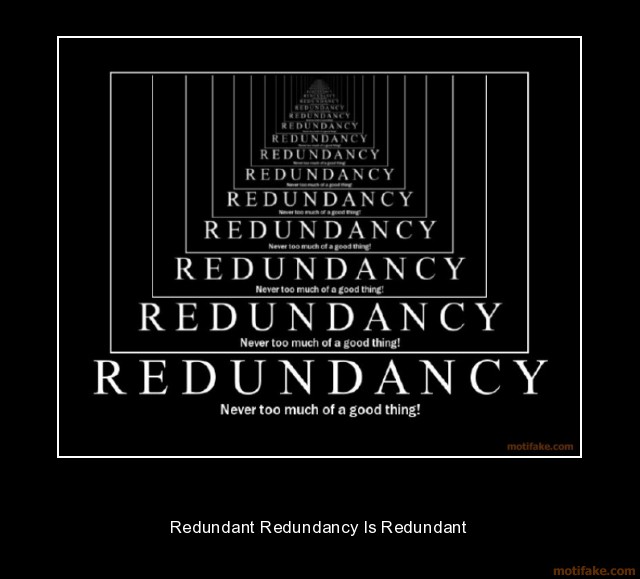(The actual image is a bit bigger. If you're having trouble seeing the image, here's the image link)
This image illustrates a connection between various information technologies that we have looked at: that redundancy in information given is incredibly important. The more information given, the better!
It's interesting because in everyday life, such as in writing and in speech, redundancy is not considered a good thing. We are encouraged to not beat around the bush and just to get to the point. Language that repeats a single point over and over again, or a point that is obvious is not considered impressive or interesting by any stretch of the mind. For example, if I wrote a story with this as an excerpt: "it was raining outside. I decided to take a walk in the rain. The rain got my hair wet. I almost slipped on the freshly rained-on concrete," the reader would probably want to throw something in frustration. The reader understood the information the first time, and it is neither useful nor interesting to repeat it over and over again.
In information technology though, redundancy is actually valuable.
Repetition of information helps catch or prevent errors or
miscommunications from occurring. We can see throughout history how redundancy in information can prevent errors and miscommunications.
For example, Gleick describes redundancy in the language of
the talking drum as "the antidote to confusion" (25). Because certain
patterns of tones could mean more than one word, adding additional
information was a necessity to make sure that the correct message got
across. While listening to the talking drum would be more time consuming
than anyone would want a normal conversation to be, redundancy
eliminated the potential for errors.
We also see Gleick detail how a lack of redundancy in abbreviated telegraph messages made them vulnerable to error. As Gleick says, "because they lacked the natural redundancy of English prose--even the foreshortened prose of telegraphese--these cleverly encoded messages could be disrupted by a mistake in a single character" (158). While the coded messages were economically friendly by reducing information to only the necessary, if hidden, core, these messages were prone to errors that couldn't be noticed without natural redundancy of language -- and in the case of the wool dealer Frank Primrose, even a single error turned out to be incredibly costly.
We also see the importance of redundancy in current digital information technologies. In one of the videos we watched, Claude Shannon - Father of the Information Age, we are told how Claude Shannon integrated redundancy to digital information -- by adding extra digital bits of information and various error detection and correction codes to any sort of digital medium, then the information can still come clearly through, even if part of the data is faulty or corrupted. (In the video, the bit on redundancy starts at about 15:03, or about there.)
While redundancy in conversation may make you want to strangle someone, it's hard to overvalue the worth redundancy of information has to information technologies throughout history. To bring it all back to the image I posted, when it comes to redundancy and information technologies, there's never too much of a good thing! With information technologies, it may be possible to say that there is really no such thing as Too Much Information.

No comments:
Post a Comment